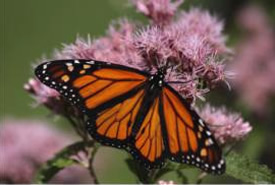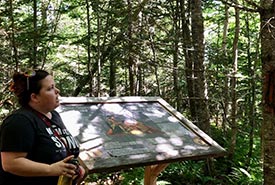NCC: Land Lines – Nature in the…parking lot?
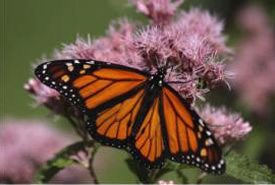
Monarch Butterfly on Joe Pye (Photo by NCC)
I work as a development officer at the Nature Conservancy of Canada and have lots of friends who are outdoorsy and also work in this field. This means that I am often swapping stories of cool wildlife sightings. The rare bird my co-worker spotted, the moose and bears they saw while paddling, the whales I saw in Newfoundland or the 50 bald eagles my friend spotted in BC are the types of stories we swap.
These stories are memorable, fun to share and often stick with me for years to come, reminding me to keep exploring and plan that next adventure. However, these stories often take place in far away places, on trips to rugged landscapes that are not easy to access, or, quite frankly, are not the kind of trips some want to take (no showers for a whole week?).
While I have been lucky to see some amazing wildlife in faraway places, some of my most memorable moments observing wildlife actually took place in a parking lot. Early in my career, I worked at a different organization alongside a team of ecologists who cared for the natural lands and habitats stewarded by the organization. My job included going out into the field each day to monitor species, collect data and control invasive species, among many other duties. I witnessed many amazing plants and animals while I was out in the field, not to mention the interactions between them. But some of the most eye-opening moments happened in the parking lot of the main office, in the mundane everyday moments walking out to the work truck in the morning, or to my car at the end of the day.
Look to the skies
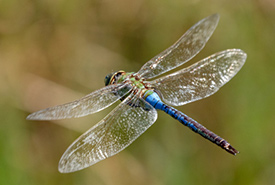
Common green darner (Photo by Nancy Norman, CC BY-NC 4.0)
Many people are aware of the amazing journey monarchs make during their migration between Canada and Mexico. One afternoon when coming in for lunch, a colleague and I noticed a steady stream of large insects flying overhead. My colleague (who is an avid entomologist) got very excited when he realized that what we were witnessing was green darner migration! I was stunned — this was the first time that I had ever heard that green darner dragonflies migrate, much like the famous monarch migration. We ended up observing the flight for nearly half an hour, and counted how many insects flew overhead (I’m not sure if we ever made it in for lunch). I don’t remember how many we counted, but it must have been in the hundreds. It would have been extremely easy to miss these insects flying overhead, but once we saw them, we couldn’t take our eyes off the sky.
Keep an eye to the ground
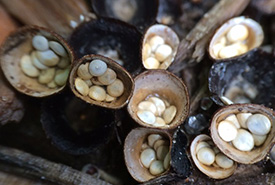
Bird’s nest fungi (Photo by Katherine Culbert)
We regularly walked past garden beds in this parking lot. They changed seasonally as different flowers bloomed and died. It would have been incredibly easy to miss a tiny piece of this garden ecosystem: the bird’s nest fungi that dotted the damp woodchips. These tiny mushrooms hold their fruiting bodies in little cup-shaped “nests” that allow rain drops to launch the fruiting body “eggs” out of the nest and to a new location where they can spread. It was another new observation for me that I had walked by countless times without noticing until my co-worker pointed it out, but now I couldn’t take my eyes off these colourful gems dotting the garden. I was clearly missing a lot of interesting things happening right before my eyes and started to be on the lookout for more.
Those clever crows
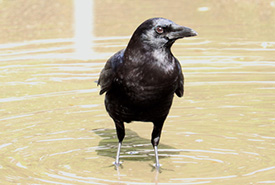
American crow (Photo by natueharak, CC BY-NC 4.0)
One of the coolest, most interesting observations I made in that parking lot (and possibly ever) was after a rainy day. It was one of those afternoons where the sun was out but there were still some lingering puddles from the rain. I noticed a few crows walking around the parking lot, throwing something into the puddles with their beaks. Crows are known to be extremely intelligent and are reported to do amazing things like build and use tools and remember human faces. Thinking I may be privy to something interesting about to happen, I took a closer look at what they were doing. I realized that they were eating squished earth worms that had been run over and dried out by the sun on the hot surface of the parking lot. But first, they seemed to be soaking the dried-up worms in the puddles before they ate them. Did soaking their dehydrated meal make the worms easier to swallow? Did it make them taste better? Help their digestion? I will probably never know, but it struck me as possibly an incredible display of their intelligence that I had heard so much about, and made me wonder if anyone else has ever seen this happen. If you have, please let me know!
All of these memories are a strong reminder for me that you don’t have to climb the highest mountain, get up at the crack of dawn or go out of your comfort zone to witness something magical. The opportunity to be wowed by nature is all around us, just waiting for us to slow down and look around.
Bonus: If you have a camera handy and are able to snap quality photos, try submitting your nature observations to iNaturalist, an online data sharing community that aims to empower people to get outside and capture images and sounds of species they encounter.

